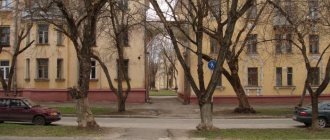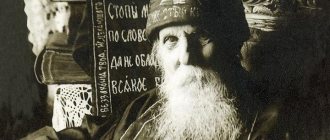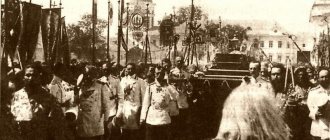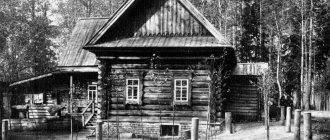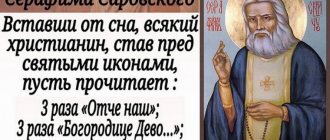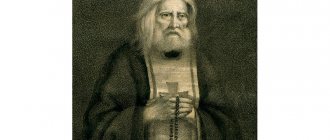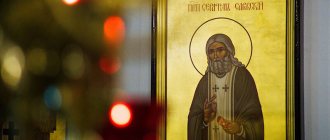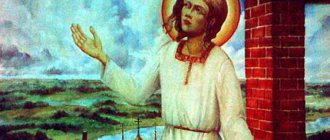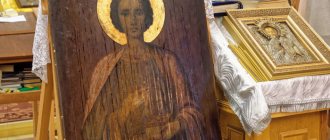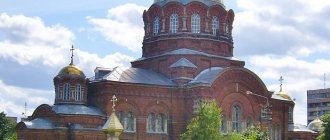| St. Seraphim of Sarov, icon of the beginning. XX century |
Seraphim of Sarov
(1754 - 1833), reverend, great ascetic of the Russian Church Memory January 2 - repose and second discovery of relics in 1991, July 19 - discovery of relics in 1903, in the Cathedrals of Kursk, Nizhny Novgorod, Tambov and Diveyevo saints
In the world Prokhor Isidorovich Moshnin, born July 19, 1754 [1]. The saint's parents, Isidore and Agathia, were residents of Kursk. Isidore was a merchant and took out contracts for the construction of buildings, and at the end of his life he began the construction of a cathedral in Kursk, but died before the completion of the work. The youngest son Prokhor remained in the care of his mother, who raised a deep faith in her son.
After the death of her husband, Agafia Moshnina, who continued the construction of the cathedral, once took Prokhor with her there, who, having stumbled, fell from the bell tower. The Lord saved the life of the future lamp of the Church: the frightened mother, going downstairs, found her son unharmed.
Young Prokhor, having an excellent memory, soon learned to read and write. Since childhood, he loved to attend church services and read the Holy Scriptures and Lives of Saints to his peers, but most of all he loved to pray or read the Holy Gospel in solitude.
One day Prokhor became seriously ill and his life was in danger. In a dream, the boy saw the Mother of God, who promised to visit and heal him. Soon a religious procession with the icon of the Sign of the Most Holy Theotokos passed through the courtyard of the Moshnin estate; his mother carried Prokhor out in her arms, and he venerated the holy icon, after which he began to quickly recover.
Even in his youth, Prokhor made the decision to completely devote his life to God and enter a monastery. The pious mother did not interfere with this and blessed him on the monastic path with a crucifix, which the monk wore on his chest all his life. Prokhor and the pilgrims set off on foot from Kursk to Kyiv to worship the Pechersk saints.
The schemamonk elder Dosifei, whom Prokhor visited, blessed him to go to the Sarov hermitage and save himself there. Returning briefly to his parents' house, Prokhor said goodbye to his mother and relatives forever.
Novice of the Sarov Desert
On November 20, 1778, he came to Sarov, where the wise old man, Father Pachomius, was then rector. He kindly received the young man and appointed Elder Joseph as his confessor. Under his leadership, Prokhor underwent many obediences in the monastery: he was the elder’s cell attendant, worked in the bakery, prosphora and carpentry shop, carried out the duties of a sexton, and performed everything with zeal and zeal, serving as if the Lord Himself. By constant work he protected himself from boredom - this, as he later said, “the most dangerous temptation for new monks, which is cured by prayer, abstinence from idle talk, feasible handicraft, reading the Word of God and patience, because it is born from cowardice, carelessness and idle talk.” .
Already in these years, Prokhor, following the example of other monks who retired into the forest to pray, asked the elder’s blessing to also go into the forest in his free time, where he prayed the Jesus Prayer in complete solitude.
Two years later, novice Prokhor fell ill with dropsy, his body became swollen, and he experienced severe suffering. The mentor, Father Joseph, and other elders who loved Prokhor looked after him. The illness lasted about three years, and not once did anyone hear a word of grumbling from him. The elders, fearing for the life of the patient, wanted to call a doctor to him, but Prokhor asked not to do this, telling Father Pachomius: “I have given myself, Holy Father, to the True Doctor of souls and bodies - our Lord Jesus Christ and His Most Pure Mother...”, and wanted to be given Holy Communion. Then Prokhor had a vision: the Mother of God appeared in an indescribable light, accompanied by the holy apostles Peter and John the Theologian. Pointing her hand at the sick man, the Most Holy Virgin said to John: “This one is from our generation.” Then she touched the patient’s side with the staff, and immediately the liquid that filled the body began to flow out through the hole formed, and he quickly recovered. Soon, on the site of the appearance of the Mother of God, a hospital church was built, one of the chapels of which was consecrated in the name of the Monks Zosima and Savvaty of Solovetsky. The altar for the chapel was built by the Monk Seraphim with his own hands from cypress wood and he always received the Holy Mysteries in this church.
Monk
On August 18, 1786, having spent eight years as a novice at the Sarov monastery, Prokhor took monastic vows with the name Seraphim, which so well expressed his fiery love for the Lord and desire to serve Him zealously.
A year later, in December 1787, Seraphim was ordained to the rank of hierodeacon. Burning in spirit, he served in the temple every day, constantly praying even after the service. The Lord vouchsafed the monk visions of grace during church services: he repeatedly saw holy angels serving with the brethren. The monk was granted a special vision of grace during the Divine Liturgy on Maundy Thursday, which was performed by the rector, Father Pachomius, and Elder Joseph. When, after the troparions, the monk said, “Lord, save the pious,” and, standing at the royal doors, pointed his orar at those praying with the exclamation “and forever and ever,” suddenly a bright ray overshadowed him. Raising his eyes, the Monk Seraphim saw the Lord Jesus Christ walking through the air from the western doors of the temple, surrounded by the Heavenly Ethereal Forces. Having reached the pulpit, the Lord blessed all those praying and entered the local image to the right of the royal doors. The Monk Seraphim, looking in spiritual delight at the wondrous phenomenon, could not utter a word or leave his place. He was led arm in arm into the altar, where he stood for another three hours, his face changing from the great grace that illuminated him. After the vision, the monk intensified his exploits: during the day he worked in the monastery, and spent his nights in prayer in a deserted forest cell.
Hieromonk
In 1793, at the age of 39, St. Seraphim was ordained to the rank of hieromonk and continued serving in the church.
Hermitage
After the death of the abbot, Father Pachomius, the Monk Seraphim, having his dying blessing for a new feat of desert living, also took the blessing from the new abbot - Father Isaiah I - and went to a desert cell a few kilometers from the monastery, in a dense forest. Here he began to indulge in solitary prayers, coming to the monastery only on Saturday, before the all-night vigil, and returning to his cell after the liturgy, during which he received communion of the Holy Mysteries.
The monk spent his life in severe exploits. He carried out his cell prayer rule according to the rules of the ancient desert monasteries; I never parted with the Holy Gospel, reading the entire New Testament during the week, and also read patristic and liturgical books. The monk learned many church hymns by heart and sang them during his work hours in the forest. Near the cell he planted a vegetable garden and built a beekeeper. Earning food for himself, the monk kept a very strict fast, eating once a day, and on Wednesday and Friday he completely abstained from food. In the first week of Holy Pentecost, he did not take food until Saturday, when he received Holy Communion. The holy elder, in solitude, was sometimes so immersed in inner heartfelt prayer that he remained motionless for a long time, neither hearing nor seeing anything around him. The hermits who visited him from time to time - schemamonk Mark the Silent and hierodeacon Alexander, having caught the saint in such prayer, quietly withdrew with reverence, so as not to disturb his contemplation.
In the summer heat, the monk collected moss from the swamp to fertilize the garden; mosquitoes mercilessly stung him, but he complacently endured this suffering, saying: “Pasions are destroyed by suffering and sorrow, either voluntary or sent by Providence.” For about three years the monk ate only one herb, snitis, which grew around his cell. In addition to the brethren, lay people began to come to him more and more often for advice and blessings. This violated his privacy. Having asked for the abbot’s blessing, the monk blocked women’s access to him, and then everyone else, having received a sign that the Lord approved of his idea of complete silence. Through the saint’s prayer, the road to his deserted cell was blocked by huge branches of centuries-old pine trees. Now only birds, which flocked in large numbers to the saint, and wild animals visited him. The monk fed the bear bread from his hands when bread was brought to him from the monastery.
Standing on a rock
Seeing the exploits of the Monk Seraphim, the enemy of the human race armed himself against him and, wanting to force the saint to leave silence, decided to frighten him, but the saint protected himself with prayer and the power of the Life-giving Cross. The devil brought “mental warfare” upon the saint—a persistent, prolonged temptation. To repel the onslaught of the enemy, the Monk Seraphim intensified his labors by taking upon himself the feat of stylite mongering. Every night he climbed a huge stone in the forest and prayed with raised hands, crying: “God, be merciful to me a sinner.” During the day, he prayed in his cell, also on a stone that he brought from the forest, leaving it only for a short rest and strengthening his body with meager food. The saint prayed like this for 1000 days and nights.
Beaten by robbers
The devil, disgraced by the monk, planned to kill him and sent robbers. Approaching the saint, who was working in the garden, the robbers began to demand money from him. The monk at that time had an ax in his hands, he was physically strong and could have defended himself, but he did not want to do this, remembering the words of the Lord: “Those who take the sword will perish by the sword” (Matthew 26:52). The saint, lowering the ax to the ground, said: “Do what you need.” The robbers began to beat the monk, broke his head with a butt, broke several ribs, then, having tied him up, they wanted to throw him into the river, but first they searched his cell in search of money. Having destroyed everything in the cell and finding nothing in it except an icon and a few potatoes, they were ashamed of their crime and left. The monk, having regained consciousness, crawled to his cell and, suffering severely, lay there all night.
The next morning, with great difficulty, he reached the monastery. The brethren were horrified when they saw the wounded ascetic. The monk lay there for eight days, suffering from his wounds; Doctors were called to him, surprised that Seraphim remained alive after such beatings. But the monk did not receive healing from doctors: the Queen of Heaven appeared to him in a subtle dream with the apostles Peter and John. Touching the head of the monk, the Most Holy Virgin granted him healing.
After this incident, the Monk Seraphim had to spend about five months in the monastery, and then he again went to a desert cell. Remaining bent forever, the monk walked, leaning on a staff or an axe, but he forgave his offenders and asked them not to punish them.
The feat of silence
After the death of the rector, Father Isaiah, who had been his friend since the saint’s youth, he took upon himself the feat of silence, completely renouncing all worldly thoughts for the purest stand before God in unceasing prayer.
If the saint met a person in the forest, he fell on his face and did not get up until the passerby moved away. The elder spent about three years in such silence, stopping even from visiting the monastery on Sundays. The fruit of silence was for St. Seraphim the acquisition of peace of soul and joy in the Holy Spirit. The great ascetic subsequently spoke to one of the monks of the monastery: “...my joy, I pray you, acquire a peaceful spirit, and then thousands of souls will be saved around you.”
Return to the monastery. Gate
The new abbot, Father Nifont, and the elder brethren of the monastery suggested that Father Seraphim either continue to come to the monastery on Sundays to participate in divine services and receive communion at the monastery of the Holy Mysteries, or return to the monastery. The monk chose the latter, since it became difficult for him to walk from the desert to the monastery. In the spring of 1810, he returned to the monastery after 15 years in the desert.
Without breaking his silence, he added seclusion to this feat and, without going anywhere or receiving anyone, he was constantly in prayer and contemplation of God. While in retreat, the Monk Seraphim acquired high spiritual purity and was granted special grace-filled gifts from God - clairvoyance and miracle-working. Then the Lord appointed His chosen one to serve people in the highest monastic feat - eldership.
Eldership
| Seraphim of Sarov |
On November 25, 1825, the Mother of God, together with the two saints celebrated on this day, appeared in a dream vision to the elder and commanded him to come out of seclusion and receive weak human souls that required instruction, consolation, guidance and healing.
Having been blessed by the abbot for a change in his lifestyle, the monk opened the doors of his cell to everyone. The elder saw the hearts of people, and he, as a spiritual doctor, healed mental and physical illnesses with prayer to God and a word of grace. Those who came to St. Seraphim felt his great love and listened with tenderness to the affectionate words with which he addressed people: “my joy, my treasure.” The elder began to visit his desert cell and the spring called Bogoslovsky, near which they built a small cell for him.
When leaving his cell, the elder always carried a knapsack with stones over his shoulders. When asked why he was doing this, the saint humbly answered: “I torment him who torments me.”
In the last period of his earthly life, the Monk Seraphim took special care of his beloved brainchild - the Diveyevo women's monastery. While still in the rank of hierodeacon, he accompanied the late rector Father Pachomius to the Diveyevo community to see the abbess nun Alexandra (Melgunova), a great ascetic, and then Father Pachomius blessed the reverend to always take care of the “Diveyevo orphans.” He was a true father for the sisters, who turned to him in all their spiritual and everyday difficulties. Disciples and spiritual friends helped the saint to care for the Diveyevo community - Mikhail Vasilyevich Manturov, who was healed by the monk from a serious illness and, on the advice of the elder, took upon himself the feat of voluntary poverty; Elena (Manturova), one of the Diveyevo sisters, who voluntarily agreed to die out of obedience to the elder for her brother, who was still needed in this life; Nikolai Alexandrovich Motovilov, also healed by the monk. ON THE. Motovilov recorded the wonderful teaching of St. Seraphim about the purpose of Christian life. In the last years of the life of the Monk Seraphim, one healed by him saw him standing in the air during prayer. The saint strictly forbade talking about this before his death.
Everyone knew and revered St. Seraphim as a great ascetic and wonderworker. A year and ten months before his death, on the Feast of the Annunciation, the Monk Seraphim was once again honored with the appearance of the Queen of Heaven, accompanied by the Baptist of the Lord John, the Apostle John the Theologian and twelve virgins, holy martyrs and saints. The Most Holy Virgin talked for a long time with the monk, entrusting the Diveyevo sisters to him. Having finished the conversation, She told him: “Soon, My beloved, you will be with us.” At this appearance, during the wondrous visit of the Mother of God, one Diveyevo old woman was present, through the prayer of the monk for her.
In the last year of his life, the Monk Seraphim began to noticeably weaken and spoke to many about his imminent death. At this time, he was often seen at the coffin, which stood in the entryway of his cell and which he had prepared for himself. The monk himself indicated the place where he should be buried - near the altar of the Assumption Cathedral.
Shortly before the blessed death of St. Seraphim, one pious monk asked him: “Why don’t we have such a strict life as the ancient ascetics led?” “Because,” answered the elder, “we do not have the determination to do so. If we had the determination, we would live like our fathers, because the grace and help of the faithful and those who seek the Lord with all their hearts is now the same as it was before, for, according to the word of God, the Lord Jesus Christ is the same yesterday and today and forever” (Heb. 13, 8).
On January 1, 1833, the Monk Seraphim came for the last time to the hospital Zosimo-Savvatievskaya Church for the liturgy and took communion of the Holy Mysteries, after which he blessed the brethren and said goodbye, saying: “Save yourself, do not be discouraged, stay awake, today crowns are being prepared for us.” On January 2, 1833, the monk’s cell attendant, Father Pavel, left his cell at six o’clock in the morning, heading to church, and smelled a burning smell coming from the monk’s cell; Candles were always burning in the saint’s cell, and he said: “As long as I am alive, there will be no fire, but when I die, my death will be revealed by fire.” When the doors were opened, it turned out that books and other things were smoldering, and the monk himself was kneeling before the icon of the Mother of God in a position of prayer, but already lifeless.
| The destruction of the Sarov monastery and the theft of the relics of St. Seraphim of Sarov. 14th stamp of the icon of the Council of New Martyrs and Confessors of Russia from the Cathedral of Christ the Savior. |
Childhood and youth
The future hieromonk Seraphim (in the world Prokhor Isidorovich Moshnin) was born in July 1759 (according to other sources - 1754) in the city of Kursk, Belgorod province, into a wealthy family. The father's name was Isidore, and the mother's name was Agathia. In addition to Prokhor, the eldest son named Alexey was already growing up in the Moshnin family.
Prokhor's father, a merchant, owned small local brick factories and was engaged in the construction of various kinds of buildings. At that time, the head of the family built both ordinary residential buildings and churches. Isidor Ivanovich began the construction of a temple in honor of St. Sergius of Radonezh, but did not have time to complete the job. When his son was little, Isidor Moshnin died, and his wife continued the unfinished business.
View this post on Instagram
A post shared by Rev. Seraphim Sarofsky (@serafim_sarovski)
Icon of Seraphim of Sarov
Since childhood, the boy gravitated towards faith, so he often asked to accompany his mother when she went to services. According to legend, at the age of about 7 years, Prokhor climbed the bell tower of a temple under construction, from where he fell from a great height, but remained safe and sound. There are disputes about this biographical fact, based on the opinion that by that time the bell tower either did not yet exist, or the building was low, and the child was not in danger.
Later, Prokhor was overcome by a severe illness. One morning the son told his mother that in a dream he saw the Virgin Mary, who promised to heal him from his illness. Then, not far from the Moshnins’ house, a church procession took place, at the head of which they carried the icon of the Sign of the Most Holy Theotokos. The woman carried her unconscious son out into the street, touched it to her face, and the illness receded. From then on, Prokhor firmly decided that he would devote his life to serving God.
New shutter
Much has changed in Seraphim’s life with the decision of Father Nifont, supported by other fathers: to oblige Seraphim to visit the monastery on Sundays and holidays, to partake of the Holy Mysteries of Christ; or, if his health does not allow him to make regular transitions, order him to return to the monastery and live in a monastery cell.
There wasn't much choice. Fulfilling the condition of obedience, the monk returned. This happened on May 8, 1810. However, having asked for a blessing, Seraphim continued to live as a recluse, but inside the monastery fence. The Holy Gifts were brought to him in his cell. During this period, the elder made himself a coffin and placed it in the entryway. After five years of such seclusion, he began to weaken it in order to serve people who needed his instructions and prayers. They say that during this period the Heavenly Queen again appeared to Father Seraphim, according to some sources, with Onuphrius the Great and Peter of Athos, demanding to serve the people.
It is believed that the elder wore heavy chains under his clothes. According to another version, the weight of the chains replaced the weight of a large five-versch cross.
Organization of the Diveyevo monastery.
In 1825, November 25, on the day of remembrance of Saints Clement of Rome and Peter of Alexandria, the Mother of God, in a sleepy vision, visited Father Seraphim along with the named saints of God, and reported that he could come out of seclusion. Around this time, sisters from the Diveyevo community began to visit Father Seraphim.
He also had a conversation with their boss, Elder Ksenia Mikhailovna. The number of sisters had by this time increased, and it was appropriate to increase the holdings. Father Seraphim suggested that she change the community charter, which was distinguished by its severity. But she refused. The monk did not interfere in the affairs of their community, considering that the commanded care of the community no longer lay on his conscience, or, at least, God’s special will should be revealed for this.
After receiving a blessing from Father Niphon to live in the desert, Seraphim went into the forest. It was still the same day, November 25, 1825. They say that on the way, he witnessed another appearance of the Mother of God. This time, two apostles were with Her: Peter and John the Theologian. When the Virgin hit the ground with her staff, a fountain of light water gushed out from the ground. The Most Holy Lady reminded the monk of his obligation related to the request of Agafya Melgunova, the order of Father Pachomius, and informed him of the need to build the Diveyevo monastery in the place indicated.
By order of the Mother of God, the monk was to take eight sisters from the community of Xenia, and at the appointed place, in the back of the village of Diveevo, to found a monastery, which only girls could enter. It was necessary to fence this place with a ditch and a rampart, install a mill, build cells, and then a church. In addition, the Mother of God gave a new charter for the monastery and promised to take it under Her protection.
At the place where Her feet were located and the healing spring flowed, a well was built, later called Serafimov. Seraphim himself made this place the place of his feat. On Sundays and holidays he remained in the monastery. The number of visitors to Father Seraphim has increased significantly. He tried to listen to them with due attention.
On December 9, 1826, the foundation of the mill was laid, and the first grinding took place in July.
Asceticism
At the age of 17, Prokhor traveled to the Kiev Pechersk Lavra as a pilgrim. There the traveler met Elder Dosithea, who blessed the guy for tonsure and ordered him to go to Sarov. The mother did not oppose her son’s choice, realizing that he was indeed somehow connected with God. After 2 years, the young man was already preparing for monasticism in the Sarov desert.
In 1786, the young man was given the name Seraphim and ordained a hierodeacon, and 6 years later - a hieromonk. The priest took charge of the local sister community, called Kazan, in 1789. Later, with the blessing of Father Seraphim and with his assistance, the Mill community appeared nearby. The lands were united into one territory after the death of the monk.
Seraphim was close to an ascetic lifestyle, like most of those who chose service. To unite with himself, the monk settled in a cell that was located in the forest. To get to the monastery, Seraphim walked a distance of about 5 km.
“Prayer, fasting, vigil and all other Christian deeds, no matter how good they are in themselves, are not only in doing...
Posted by St. George Russian Orthodox Church — Salt Lake City, UT on Saturday, July 31, 2021
Seraphim of Sarov with a bear
It is known from his life that the hieromonk wore the same clothes in winter and summer and independently found food in the forest. Seraphim of Sarov slept briefly, kept the strictest fast, re-read the Holy Scriptures and often indulged in prayer.
For years, Seraphim ate only grass. In addition, the elder chose a special type of feat - pillarism, in which he continuously prayed on a boulder for 1000 days and nights. So Seraphim began to be called the venerable, that is, similar behavior to Jesus Christ. However, this information is questioned by both secular authors and representatives of the Church.
In the life of Sarovsky, a case is described of how one day the robbers, having found out that Seraphim had wealthy guests, considered that the monk had managed to get rich. While the hieromonk was praying, robbers attacked and beat him. Seraphim did not offer any resistance, despite his strength, power and youth. But the criminals did not find any wealth in the ascetic’s cell. The monk survived, but after what happened he remained hunched over. The criminals were caught, but Father Seraphim granted forgiveness to the guilty.
Posted by Tambov Diocese on Wednesday, November 6, 2019
Monument to Seraphim of Sarov in Orel
Since 1807, Seraphim of Sarov tried to meet and talk with people as little as possible, starting a new feat - silence. After 3 years, the elder returned to the monastery, but went into seclusion for 15 years, after which he resumed his receptions. Seraphim met not only with the laity, but also with the clergy, having acquired, as can be learned from books about his life, the gift of prophecy and healing.
It is worth noting that, although the hieromonk’s childhood and youth were spent in prosperity, Seraphim was well aware that ordinary people had to regularly face hard work. Perhaps that is why the monk recommended that the laity adhere to a short prayer rule, so as not to be too distracted from earthly worries.
Seraphim of Sarov died in 1833 in his cell. The event occurred when the elder was performing the ritual of kneeling prayer. Remembrance Day of the Wonderworker is January 2.
The beginning of the monastic exploits of St. Seraphim of Sarov
The abbot of the monastery, Elder Pachomius, entrusted the spiritual guardianship of Prokhor to the wise and experienced ascetic, treasurer, Elder Joseph. Initially, Prokhor was assigned the obedience of a cell attendant. As the stay continued, one obedience was replaced by another. Prokhor worked meekly and diligently both in the bakery, in the prosphora, and in the carpentry; He served as an alarm clock, then as a sexton, and together with his brothers he prepared firewood.
Prokhor prayed a lot, read, and observed abstinence. Having in mind examples from the lives of the great desert dwellers and gravitating toward solitude, he asked for a blessing to retire to the forest during hours free from obedience and duties. There he built a small hut for himself and devoted himself to contemplation and prayer in it.
About 2 years after entering the monastery, Prokhor fell ill and became swollen. This illness, presumably dropsy, lasted for almost three years. Prokhor's illness was so serious that they began to fear for his life. But by the grace of God he was healed: one day, after communion of the Holy Mysteries of Christ, the Mother of God appeared to him, accompanied by the apostles Peter and John, and after Her miraculous intervention the disease receded.
Subsequently, at the site of this miracle, they began to build a hospital building, and with it a church. They claim that the site of the appearance of the Mother of God was on the altar of the temple being built. A financial levy was authorized for construction. Prokhor willingly accepted the collector’s obedience. Walking around different places for this purpose, he reached Kursk, where he met with his relatives. His brother, Alexey, made a significant contribution to the construction. After this, Prokhor returned to the monastery. Being a skilled carpenter, he personally made a throne for the church.
On August 13, 1786, Abbot Pachomius tonsured Prokhor to the rank of monk. From that time on, Prokhor adopted a new name - Seraphim. And a little later, on October 27, 1786, the Bishop of Vladimir and Murom, His Eminence Victor, Seraphim was ordained to the rank of hierodeacon. They claim that during the period of his diaconal service he more than once contemplated angelic powers at the Divine Liturgy.
On September 2, 1793, Bishop Theophilus ordained Seraphim as hieromonk. About a year later, Father Pachomius died. Before this, he entrusted Father Seraphim with the care of the Diveyevo sisters, which, in turn, was asked of him before his death by their abbess, Elder Agafya Melgunova.
From that time on, Father Seraphim, prepared by Providence for life in solitude, asked the new abbot, Father Isaiah, for a blessing to live in the desert. This happened 16 years after Prokhor’s arrival at the monastery. In addition to internal reasons, the reverend’s physical illness contributed to this decision. From incessant pastoral labors and kneeling cell prayers, Father Seraphim’s feet became covered with wounds and swollen; It was difficult for him to bear monastic obedience.
Life
Hieromonk Sergius began to describe the life of Seraphim 4 years after the death of the saint. Subsequently, the work, which, however, was edited several times, served as the main source of information about Sarovsky. As an appendix to Sergius’s work, the elder’s recommendations were published, supplemented and republished in 1838 as “Spiritual Instructions for Monks and Laymen.”
It is worth noting that the lion's share of the teachings of St. Seraphim of Sarov was collected by landowner Nikolai Motovilov. However, the reliability of Motovilov's notes has been questioned.
Venerable Seraphim of Sarov.
XIX century. Kept in the Museum of the Moscow Theological Academy. A picturesque portrait by an unknown artist. Posted by Tatyana Gavrilenko on Saturday, July 31, 2021
Lifetime portrait of Seraphim of Sarov
In 1841, Metropolitan Philaret rewrote his life. The clergyman’s desire to bring the available information into compliance with the censorship requirements of that time had an impact.
The editor of the next edition was the rector of the Nikolo-Borsk Hermitage Georgy. The monk added wonderful details to the book: stories about the animals that the monk fed, about the increase in food and the appearances of the Virgin Mary.
The history of the publication of the elder's teachings
Instructions about. Seraphim has been preserved mainly from the last period of his life, when he had already established himself as an ascetic and confessor.
At the same time, Fr. Seraphim did not specifically write any essays. His instructions were recorded by spiritual children and are known from the recollections of people who personally knew the elder.
The elder’s teachings were first published in a small book in 1839. The work of collecting sayings and spiritual advice from Fr. Seraphim took over as priest. Sergius (Vasiliev), tonsured at the Sarov monastery. At first he was going to publish the elder’s teachings along with his life story, but the life story was not passed by the censorship committee. As a result, the instructions were published as an appendix to the biography of another Sarov ascetic, Mark. Later instructions from St. Seraphim began to be published as part of his life.
Canonization and discovery of relics
They began to venerate Seraphim during his lifetime, and the elder was canonized at the insistence of Nicholas II’s wife, Alexandra Fedorovna. This happened on July 19, 1902. According to rumors, the imperial couple believed that it was thanks to the prayers of Father Seraphim that an heir appeared in the royal family. In addition, the saint was loved by the people, and the Romanovs, in matters of faith, sought not to distance themselves from their subjects.
This development of events caused a whole scandal, headed by Konstantin Pobedonostsev, who served as the emperor’s representative in the Holy Synod. The latter did not consider the tsar’s order to correspond to church canons.
Beaten by robbers.
Posted by Rusu Silvia on Friday, January 15, 2021
Seraphim of Sarov with the robbers
Partly, they were in no hurry to canonize Seraphim of Sarov because of information indicating the saint’s sympathy for the Old Believers. There is still debate about how the hieromonk actually treated schismatics.
In the fall of 1920, the district congress of Soviets in Temnikov decided to open the shrine containing the elder’s relics, which happened at the end of the year. In 1922, the remains of Seraphim of Sarov ended up in the Museum of Religious Art in the Donskoy Monastery, where they were then simply lost.
In 1990, unknown human bones were discovered in the collections of the Museum of the History of Religion at the Kazan Cathedral in St. Petersburg. Thanks to the preserved autopsy report, it was possible to establish that the remains belong to Seraphim of Sarov. The discovery of the relics took place on August 1, 1991, after the solemn meeting of the hieromonk’s tomb in Diveyevo.
Heritage
Orthodox Christians continue to pray to Seraphim of Sarov. The press has repeatedly reported about healings from various ailments of people who came to the relics of the saint, predictions and other miracles associated with the elder.
Believers know more than one prayer to Father Seraphim. The monk helps in healing, admirers ask the miracle worker to give harmony and mental fortitude. Often people come to the icon so that the saint can guide them on the right path. Often businessmen pray to Seraphim, wanting success in business and trade. Young girls ask to send a companion.
Today there are churches of Seraphim of Sarov in almost every city in Russia, including Moscow, St. Petersburg and Kazan. There are parishes in honor of the saint in small villages. Akathists to the saint are heard even overseas.
Where is the icon?
As noted above, one of the first icons is in America. In general, today, perhaps, there is not a single Orthodox church where there is not an image of Seraphim of Sarov.
And, of course, the oldest icon is located in the Sarov Monastery in the Nizhny Novgorod region.
The miraculous face is located in Old Peterhof at the Seraphim Cemetery.
The miraculous image is kept in Estonia in the Church of the Resurrection of Christ.
One of the most famous images of an old man with a stone is kept in the Elokhovsky Epiphany Cathedral.
Some of the elder’s relics remained in the Danilov Monastery. Two miraculous lists are also stored here.
Interesting Facts
- It is known that Father Seraphim planted a vegetable garden and set up an apiary next to his cell. Perhaps the cleric’s presence of honey gave rise to the legend of hand-feeding bears.
- According to rumors, the first coffin of the saint, made of marble and silver, was a gift from Nicholas II. In addition, there is information that the Empress herself embroidered the shrine cover.
- The source for painting the icon of Seraphim of Sarov was a portrait created 5 years before the death of the hieromonk by an artist named Serebryakov, who later became a monk.
